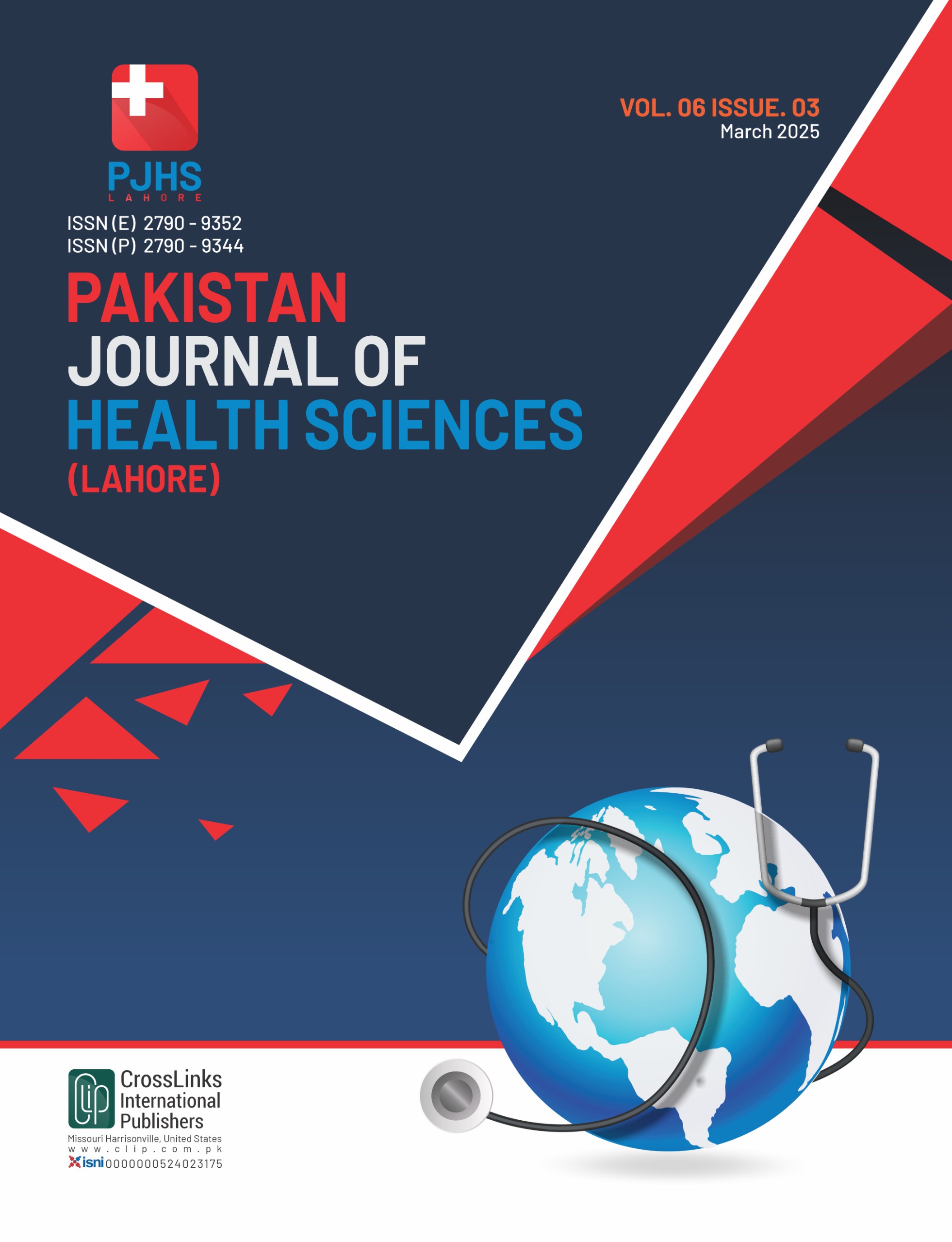Outcome of Low Molecular Weight Heparin Use in Pregnant Women with Oligohydramnios at A Tertiary Care Hospital
Heparin Use in Pregnant Women with Oligohydramnios
DOI:
https://doi.org/10.54393/pjhs.v6i3.2832Keywords:
Oligohydramnios, Low Molecular Weight Heparin, Outcomes, Maternal RisksAbstract
Oligohydramnios refers to an antenatal condition in which the amniotic fluid volume is abnormally low and has poor fetal consequences. This research strives to elaborate on the convoluted connections between oligohydramnios and the associated maternal and fetal risks. Objectives: To find out the frequency of pregnancy outcomes in pregnant women with oligohydramnios using low molecular weight heparin (LMWH). Methods: The prospective cohort study was conducted at the Obstetrics Department of Nishtar Hospital, Pakistan from November 2024 to January 2025. One hundred and twenty-two women fulfilling the inclusion criteria were included. Patients were given 40 mg LMWH subcutaneously once a day. The patients were followed till delivery to determine outcomes including live birth, preterm delivery, weight at birth, admission to the Neonatal Intensive Care Unit (NICU) and pre-eclampsia. SPSS version 26.0 was employed to analyze the data. Results: Out of 122 participants, 120 (98.4%) resulted in live births while 2 (1.6%) were intra-uterine deaths. Among all births, 21 (17.2%) were delivered preterm while 101 (82.8%) were delivered at term. 108 (88.5) weighed >2.5 kg. Among 120 live births, 23 (19.2%) were admitted to the NICU for observation or treatment. Conclusions: It was concluded that the study results support the use of LMWH in oligohydramnios as a proportion of adverse perinatal outcomes was low in our study. LMWH was found to be efficacious, authentic and safe in oligohydramnios to achieve desired clinical outcomes and decrease the burden of associated morbidities and mortalities in the targeted population.
References
Bhatti G, Romero R, Gomez-Lopez N, Chaiworapongsa T, Jung E, Gotsch F et al. The Amniotic Fluid Proteome Changes with Gestational Age in Normal Pregnancy: A Cross-Sectional Study. Scientific Reports. 2022 Jan; 12(1): 601. doi: 10.1038/s41598-021-04050-9. DOI: https://doi.org/10.1038/s41598-021-04050-9
Shamsnajafabadi H and Soheili ZS. Amniotic Fluid Characteristics and Its Application in Stem Cell Therapy: A Review. International Journal of Reproductive Bio-Medicine. 2022 Sep; 20(8): 627. doi: 10.18502/ijrm.v20i8.11752. DOI: https://doi.org/10.18502/ijrm.v20i8.11752
Wiechers C, Bernhard W, Goelz R, Poets CF, Franz AR. Optimizing Early Neonatal Nutrition and Dietary Pattern in Premature Infants. International Journal of Environmental Research and Public Health. 2021 Jul; 18(14): 7544. doi: 10.3390/ijerph18147544. DOI: https://doi.org/10.3390/ijerph18147544
David AL and Spencer RN. Clinical Assessment of Fetal Well‐Being and Fetal Safety Indicators. The Journal of Clinical Pharmacology. 2022 Sep; 62: S67-78. doi: 10.1002/jcph.2126. DOI: https://doi.org/10.1002/jcph.2126
Zilberman Sharon N, Pekar-Zlotin M, Kugler N, Accart Z, Nimrodi M, Melcer Y et al. Oligohydramnios: How Severe Is Severe? The Journal of Maternal-fetal and Neonatal Medicine. 2022 Dec; 35(25): 5754-60. doi: 10.1080/14767058.2021.1892068. DOI: https://doi.org/10.1080/14767058.2021.1892068
Huri M, Di Tommaso M, Seravalli V. Amniotic Fluid Disorders: From Prenatal Management to Neonatal Outcomes. Children. 2023 Mar; 10(3): 561. doi: 10.3390/children10030561. DOI: https://doi.org/10.3390/children10030561
Tithy SA. Pregnancy Outcome between Oligohydramnios and Borderline Amniotic Fluid Index. Scholars International Journal of Obstetrics and Gynecology. 2022; 5(10): 448-54. doi: 10.36348/sijog.2022.v05i10.004.
Bumrah S, Grover S, Kaur K, Rajora P, Tapasvi I. Clinico-Epidemiologic Profile and Perinatal Outcome of Patients with Oligohydramnios in Third Trimester in A Tertiary Care Hospital. International Journal of Reproduction, Contraception, Obstetrics and Gynecology. 2023 May; 12(5): 1222-7. doi: 10.18203/2320-1770.ijrcog20231035. DOI: https://doi.org/10.18203/2320-1770.ijrcog20231035
Masood A, Ujala S, Anwar S. Mode of Delivery and Perinatal Outcomes of Oligohydramnios: A Study at A Tertiary Care Hospital in Bahawalpur, Pakistan. Rawal Medical Journal. 2021 Aug; 46(3): 632-.
Guerby P, Fillion A, O'Connor S, Bujold E. Heparin for Preventing Adverse Obstetrical Outcomes in Pregnant Women with Antiphospholipid Syndrome, A Systematic Review and Meta-Analysis. Journal of Gynecology Obstetrics and Human Reproduction. 2021 Feb; 50(2): 101974. doi: 10.1016/j.jogoh.2020.101974. DOI: https://doi.org/10.1016/j.jogoh.2020.101974
Rasheedy R, El Bishry G, Tarek R. Maternal Low Molecular Weight Heparin Versus Sildenafil Citrate for Fetal Growth Restriction: A Randomized, Parallel Groups, Open-Label Clinical Trial. Journal of Perinatology. 2020 May; 40(5): 715-23. doi: 10.1038/s41372-019-0544-1. DOI: https://doi.org/10.1038/s41372-019-0544-1
Malloy RJ, Rimsans J, Rhoten M, Sylvester K, Fanikos J. Unfractionated Heparin and Low-Molecular-Weight Heparin. Anticoagulation Therapy. 2018: 31-57. doi: 10.1007/978-3-319-73709-6_3. DOI: https://doi.org/10.1007/978-3-319-73709-6_3
Twesigomwe G, Migisha R, Agaba DC, Owaraganise A, Aheisibwe H, Tibaijuka L et al. Prevalence and Associated Factors of Oligohydramnios in Pregnancies Beyond 36 Weeks of Gestation at A Tertiary Hospital in Southwestern Uganda. BioMed Central Pregnancy and Childbirth. 2022 Aug; 22(1): 610. doi: 10.1186/s12884-022-04939-x. DOI: https://doi.org/10.1186/s12884-022-04939-x
Mushtaq N, Zubair M, Ehsan A, Shabir N, Batool M. Oligohydramnios as Prognostic Factor for Maternal Risk in Term Pregnancy and Fetal Outcome. Journal of the Society of Obstetricians and Gynaecologists of Pakistan. 2023 May; 13(2): 92-6.
Bistervels IM, Buchmüller A, Wiegers HM, Áinle FN, Tardy B, Donnelly J Et Al. Intermediate-Dose Versus Low-Dose Low-Molecular-Weight Heparin in Pregnant and Post-Partum Women with A History of Venous Thromboembolism (Highlow Study): An Open-Label, Multicenter, Randomized, Controlled Trial. The Lancet. 2022 Nov; 400(10365): 1777-87.
Mohammed SS and Ahmed AA. Prevalence Rate, Probable Causes, and Perinatal Outcomes in Women with Oligohydramnios in Labor. Cureus. 2024 May; 16(5). doi: 10.7759/cureus.61290
Bakhsh H, Alenizy H, Alenazi S, Alnasser S, Alanazi N, Alsowinea M et al. Amniotic Fluid Disorders and the Effects On Prenatal Outcome: A Retrospective Cohort Study. BioMed Central Pregnancy and Childbirth. 2021 Dec; 21: 1-7. doi: 10.1186/s12884-021-03549-3. DOI: https://doi.org/10.1186/s12884-021-03549-3
Zaman Z, Imran F, Iqbal MJ. Role of Enoxaparin to Improve Obstetrical Outcome in Patients with IUGR and Oligohydramnios. Journal of the Society of Obstetricians and Gynaecologists of Pakistan. 2018; 8(4): 232-7.
Zullino S, Clemenza S, Mecacci F, Petraglia F. Low Molecular Weight Heparins (LMWH) and Implications Along Pregnancy: A Focus On the Placenta. Reproductive Sciences. 2022 May; 29(5): 1414-23. doi: 10.1007/s43032-021-00678-0. DOI: https://doi.org/10.1007/s43032-021-00678-0
Cruz-Lemini M, Vázquez JC, Ullmo J, Llurba E. Low-Molecular-Weight Heparin for Prevention of Preeclampsia and Other Placenta-Mediated Complications: A Systematic Review and Meta-Analysis. American Journal of Obstetrics and Gynecology. 2022 Feb; 226(2): S1126-44. doi: 10.1016/j.ajog.2020.11.006. DOI: https://doi.org/10.1016/j.ajog.2020.11.006
Chen M, Chen YT, Chen CM, Wu WJ, Lin WH, Ma GC. Benefits and Risks of Low Molecular Weight Heparin Use On Reproductive Outcomes: A Retrospective Cohort Study. Taiwanese Journal of Obstetrics and Gynecology. 2022 Sep; 61(5): 812-7. doi: 10.1016/j.tjog.2022.05.015. DOI: https://doi.org/10.1016/j.tjog.2022.05.015
Iftikhar B, Shahid A, Akram NA, Afsheen A, Mushtaq R, Ehsan A. Single Centre, Open-Label & Non-Randomized Clinical Trial Testing Lmwh Efficacy On Perinatal Outcome in Late Second Trimester Oligohydramnios Cases. Parity. 2021 Jun; 14(5): 3. doi: 10.51253/pafmj.v71i3.4992. DOI: https://doi.org/10.51253/pafmj.v71i3.4992
Sultana M, Batool A, Sher Z, Suliman N, Rafay A, Sharif A. Comparison of the Effect of Injection Enoxaparin Versus Conventional Treatment On Amniotic Fluid Index in Borderline Oligohydramnios in Third Trimester of Pregnancy: A Randomized Control Trial in A Tertiary Care Hospital. Nigerian Medical Journal. 2023; 64(4): 556-62.
Downloads
Published
How to Cite
Issue
Section
License
Copyright (c) 2025 Pakistan Journal of Health Sciences

This work is licensed under a Creative Commons Attribution 4.0 International License.
This is an open-access journal and all the published articles / items are distributed under the terms of the Creative Commons Attribution License, which permits unrestricted use, distribution, and reproduction in any medium, provided the original author and source are credited. For comments













